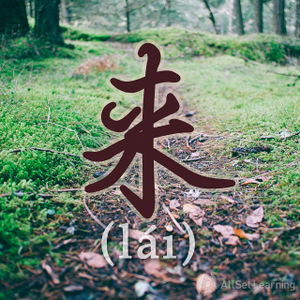Difference between revisions of "Using "lai" to connect two verb phrases"
m (→Examples) |
|||
| Line 18: | Line 18: | ||
<div class="liju"> | <div class="liju"> | ||
* 中国人<strong>用</strong> 筷子 <em>来</em> 吃饭。<span class="pinyin">Zhōngguó rén <strong>yòng</strong> kuàizi <em>lái</em> chīfàn.</span><span class="trans">Chinese people use chopsticks in order to eat.</span> | * 中国人<strong>用</strong> 筷子 <em>来</em> 吃饭。<span class="pinyin">Zhōngguó rén <strong>yòng</strong> kuàizi <em>lái</em> chīfàn.</span><span class="trans">Chinese people use chopsticks in order to eat.</span> | ||
| − | * <strong>用</strong> 这 种 方法 <em>来</em> 赚钱,真 丢人。<span class="pinyin"><strong>Yòng</strong> zhè zhǒng fāngfǎ <em>lái</em> zhuànqián, zhēn diūrén.</span><span class="trans">Using this method | + | * <strong>用</strong> 这 种 方法 <em>来</em> 赚钱,真 丢人。<span class="pinyin"><strong>Yòng</strong> zhè zhǒng fāngfǎ <em>lái</em> zhuànqián, zhēn diūrén.</span><span class="trans">Using this method to earn money is shameful.</span> |
* 你 可 以 <strong>用</strong> 米饭 <em>来</em> 当 胶水。<span class="pinyin">Nǐ kěyǐ <strong>yòng</strong> mǐfàn <em>lái</em> dāng jiāoshuǐ.</span><span class="trans">You can use rice as glue.</span> | * 你 可 以 <strong>用</strong> 米饭 <em>来</em> 当 胶水。<span class="pinyin">Nǐ kěyǐ <strong>yòng</strong> mǐfàn <em>lái</em> dāng jiāoshuǐ.</span><span class="trans">You can use rice as glue.</span> | ||
* 我们 可以 <strong>通过</strong> 打折 <em>来</em> 吸引 顾客。<span class="pinyin">Wǒmen kěyǐ <strong>tōngguò</strong> dǎzhé <em>lái</em> xīyǐn gùkè.</span><span class="trans">We can use a sale as a method to attract customers.</span> | * 我们 可以 <strong>通过</strong> 打折 <em>来</em> 吸引 顾客。<span class="pinyin">Wǒmen kěyǐ <strong>tōngguò</strong> dǎzhé <em>lái</em> xīyǐn gùkè.</span><span class="trans">We can use a sale as a method to attract customers.</span> | ||
Revision as of 07:36, 25 June 2015
| This article is a stub. Editors can help the Chinese Grammar Wiki by expanding it. |
-
Level
-
Similar to
-
Used for
-
Keywords
The word 来 (lái) can be used to connect two verb phrases, relating the actions to each other. It can be translated as "in order to" or "so that" and it can help in explaining reasoning.
Structure
Connecting two verb phrases is very straightforward. All you need to do is place 来 in between them. This has the meaning of doing the first verb to achieve the second verb. Often used with words expressing a way or a method, e.g. "通过" (tōng guò) , "用" (yòng).
通过/用 + Verb Phrase 1 + 来 + Verb Phrase 2
Examples
- 中国人用 筷子 来 吃饭。Chinese people use chopsticks in order to eat.
- 用 这 种 方法 来 赚钱,真 丢人。Using this method to earn money is shameful.
- 你 可 以 用 米饭 来 当 胶水。You can use rice as glue.
- 我们 可以 通过 打折 来 吸引 顾客。We can use a sale as a method to attract customers.
- 你 只能 通过 自己 努力 来 找 到 好 工作。You can only use your own efforts in order to find a good job.
See Also
Sources and Further Reading
- Integrated Chinese: Level 2, Part 1 (pp. 268) →buy



